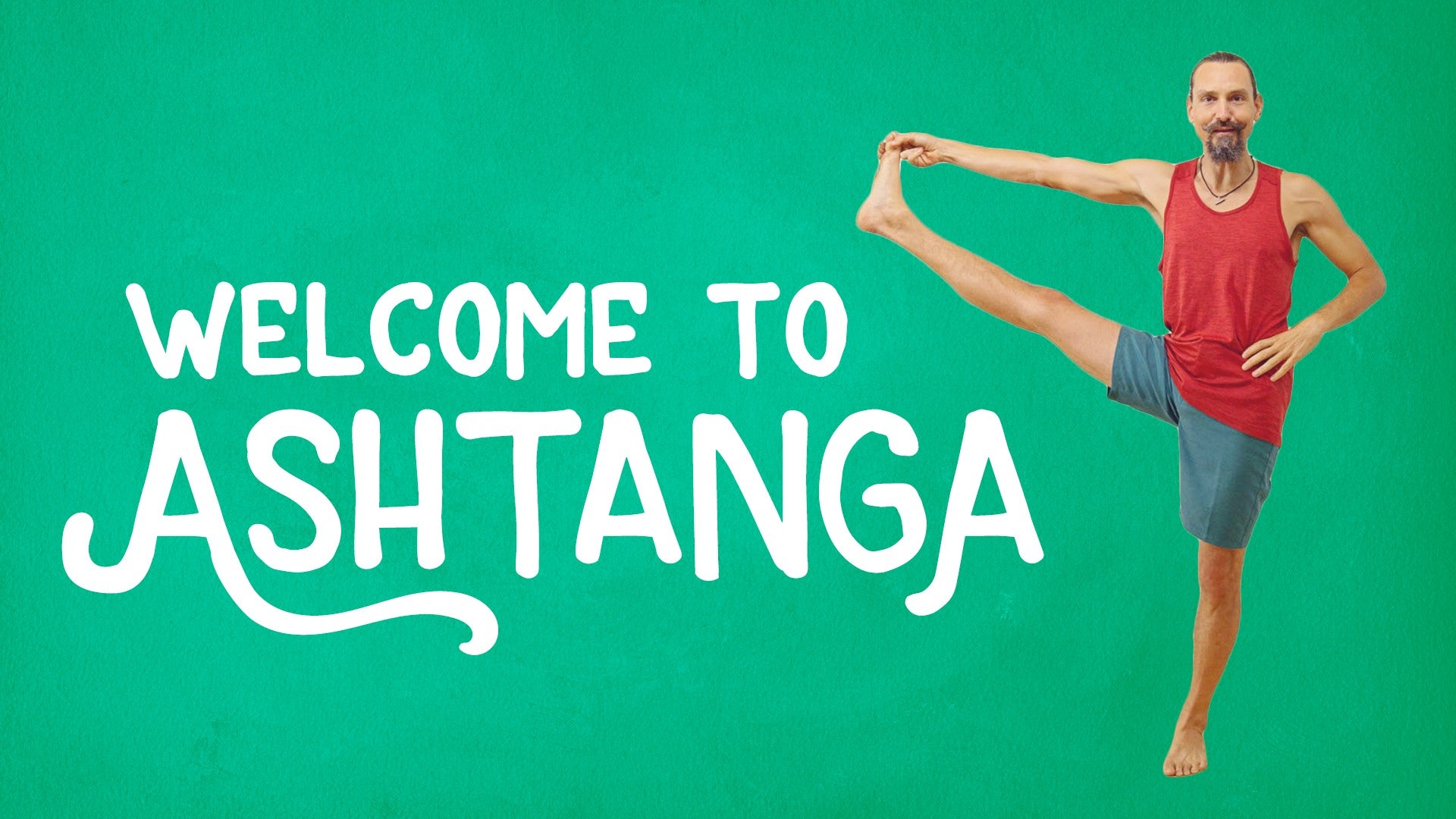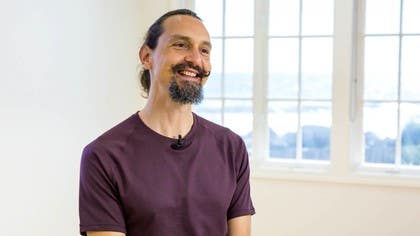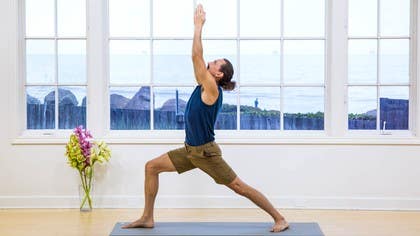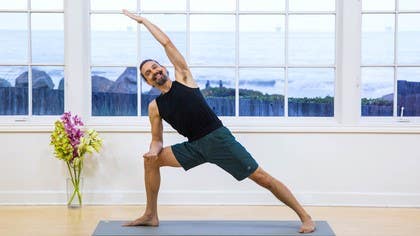Description
About This Video
Transcript
Read Full Transcript
What is Ashtanga? That's a big question. Well, Ashtanga, as we know it, is a set series of practices, postures, linked together on a very exact breath count. So with continued practice, the Ashtanga practice then becomes really a breath management technique. But beyond that and deeper, Ashtanga then, as one looks at how they're using the breath, becomes an examination of all of one's processes. Yes, breath, but heartbeat, emotional response, what happens in flight or fight, panic. So Ashtanga then becomes really looking at the contents of the mind, the contents of the entirety of one's process. So it's very difficult to say where Ashtanga stops and where daily life begins. But I don't mean to say one's entire life should just be oriented around getting onto the mat and breathing in the exact same set series of patterns. Very useful, very, very incredibly transformative, if not transcendent, useful technique. But with time, the benefits of that practice and looking that deeply into your breath, into your process, starts to spill out just like all genuine yoga so that everything you do has a new color, a new tint, seeing the world through some rose-colored glasses. So how you practice becomes incredibly important. If you're practicing in some kind of Draconian pain-based practice, then I think the danger would be that you leave and your entire life looks like that. You just only are seeing the suffering, the suffering, the suffering. But if you're practicing in a way that's gentle and nurturing and allowing yourself the space and the freedom to explore what is best for you at the moment, then hey, your whole life becomes colored with that process and you are really informed, you become a source of wisdom to your own life. And I think Ashtanga really ties in with all the deep and traditional meditative practices. This is a reason why I believe Shri K. Patabi Joyce called this system Ashtanga. He didn't call it Joyce yoga, Patabi yoga, though he certainly could have, no one would have argued, I think. Instead he called it Ashtanga to call upon his teacher and his teacher's teacher and call upon a lineage to encourage us, especially I think the Westerners, to look back and look into the Patanjali system, look at the yamas, niyamas, the eight limbs, and to look past the Asana. Though Shri K. Patabi Joyce was primarily teaching the Westerners Asana, vinyasa, breath management, certainly was exploring philosophy, but really encouraging us to look and make that study a practice within our own lives. So I think it's very difficult to say where Ashtanga ends, but it is at its highest form, at its truest form, and its most idealized state. Ashtanga is a practice which permeates, transforms, and colors all aspects of the practitioner's existence. The obstacles to Ashtanga, the market of our modern day in yoga and all commercial activities, is telling us we deserve something. We've worked hard so we deserve something that's quick and easy, fast and fun, and Ashtanga unfortunately is none of these things. Ashtanga is difficult, it's traditional, it's ancient, and Ashtanga requires a lot of patience to really reap the highest benefit and see the highest reward. You've got to be incredibly patient, and I think our modern society has led us away from patience. The traditional yogic practices lead us back towards patience, so perhaps our own modern impatience is the biggest obstacle to Ashtanga. The good news is that Ashtanga is also the antidote. If you keep practicing, slowly you learn detachment, and the sooner you can pick it up, fine, the better. You realize, oh, there's no point to trying to make this posture perfect today, but instead to come back to it again and again and again, and feel the refinements happening, not only in the posture, in the breath, and in the contents of the mind, seeing a refined process occur, and having the patience to allow that to unfold into your daily life. The benefits of Ashtanga. From my very limited experience, I've seen that the benefits continue to be higher and higher. That is more subtle and more subtle. Deeper and deeper might be a better way to say it. That at first, okay, there's a transformation of the physical body, but with time, one can see that there's a transformation of the mental processes, a huge amount of mental clarity that occurs, a lot of restraint and patience, and just being able to make much better choices about how we're going to navigate this interesting modern life, to not be swept away with the easy way, or the easy choice, to not be swept away with simple sensory pleasures, but instead to really focus on genuine sadhana and being of service. I think the obvious qualities of a genuine student and practitioner, at first, are showing up every day. There's the dedication, the regular practice, and being present on the mat. Again, those are the obvious qualities, but I think as a teacher, and with experienced teachers, I think we're looking into the more subtle qualities of a student. There are lots of motivators to give people to the mat every day. Some people are seeking physical benefit, or praise and reward, or some kind of tangible measurement of muscle mass, or fat loss, or something like that, which might help to get you to the mat, but for genuine practice, what I see is not only that abhyasa, that consistent, steadfast, uninterrupted practice, but vedagyam. You can tell when a student is reaping such high benefit, such deep benefit to their practice, that they're no longer interested in any kind of measurable, or tangible, or instantaneous reward. So I think when I see that detachment, that's when I know we've got some really interesting ground to work with, where a student might be ready to take on deeper and deeper teachings and practices. Vaidagyam, it's such an important part of all traditional yogic practices. It goes hand-in-hand with abhyasa. I would say consistent, steadfast practice, abhyasa, is worthless without vaidagyam, without detachment. What kind of detachment? The Gita, Bhagavad Gita, would specifically point us towards detachment from the results of our actions, detachment from the fruits of our labors. So for the yoga, sabhika, for the person practicing yoga, then finding some result, some reward, should not be the fuel for the engine, should not keep us on the mat because we know things will get better, or I will have these measurables. But instead, just going through life, practicing, practicing, and detached from the results. I think without that, the yoga practice winds up like a workout, or some kind of simple reward, chemistry, fitness exercise. There was nothing wrong with those exercises, but yoga was traditionally taught as something far more transcendent. Not just transformational, not just changing your physical body or your emotion or your mind, but transcending the human condition of needing and seeking and looking for more, or looking for validation, which is so big in our externalized world with our clicks and our likes, but just accepting and being exactly as we are. And I think that yoga, ashtanga, and all yogas do offer that fruit with vayagyam, with detachment. Yeah, I've been practicing since I was very young, even younger than today. This year marks my 30th year of yoga practice, sitting meditation and asana, and for me there are always two sides of the same coin. About half of that has been, the latter half has been daily ashtanga practice. I think the practice really sweetens and blossoms as one ages. I think I was lucky to have very fine teachers early on who showed me the practice wasn't forcing oneself to make a bodily shape. And from that then, to be able to really appreciate one's process and know that some days a practice will be longer, and some days a practice will be shorter, and some days a practice will involve more sitting and more breathing. And some days a practice might involve more asana, to know that that's a possibility. As I age, it's been really useful and wonderful to go through all the seasons and to know that things work in a cycle too. It's not that, as I've gone deep into my 40s now, it's not that I'm doing less asana and more pranayama and more sitting, it's that I actually still transform and change, and there may be some months where I'm doing a lot of asana, and then there's some months where I'm doing a lot more sitting. But yeah, how would I say that aging has informed me about the longevity of practice? I would say that I was lucky to have good teachers along the way who really helped me see that practice was not about achieving something today, but instead about looking at one's own process and delivering to oneself the medicine of what's going to be best for one in the moment. Stillness in action is something that I think I've been toying with for the last 30 years, or it's been an area of exploration. So movement practices to me are very interesting, and stillness practices are very interesting as well.
To me, ashtanga is a stillness practice, though it involves moving the body. But beyond just the physical movements of the body, I'm interested in action, or karma, and Sanskrit, so that there's volitional choice which might create equal and opposite reaction, and that we're involved in a pattern of unfolding change, some call it samsara, this wheel of action and reaction. But if we can establish stillness without dropping our daily lives, if we can work from a place of what some Buddhist might call shunyata, of emptiness or of stillness, then we can go through daily life proceeding through our actions without creating these turbulent waves of karma, which we're going to have to surf later on. So the ashtanga practice, then, I think is a perfect vehicle to practice that because we have this wonderful cheat. We have mula bandha and udiyana bandha, which can work on the physical level to reveal the metaphysical, that we can try to engage emptiness at our very core, that we can try to find a drawing in and up of mula and udiyana bandha, so that even as we do eccentric movements and jumping around at our very center physically, there's a stillness. There's a conscious stilling of the center, and that when we go off into daily life and we do all sorts of things, flying and making companies and doing whatever we're doing, we're still moving from a place of stillness. So I think stillness in action for me, it's really the essence of all the teachings about karma and how to avoid making unpleasant waves and ripple effect for oneself and others. It's finding that stillness and clinging to stillness even as we proceed through practice and daily life. Looking into the subtleties of the breath, I think it's a never-ending process. I think the more we look at the breath, the more subtleties reveal themselves, and it's become commonplace in nowadays in yoga and throughout the world for people to say stop and look at your breath. It's become so commonplace, I wonder how many of us are actually doing it because it's actually fascinating. We look at some of the oldest teachings, recorded teachings, that we believe the Buddha taught, including the anapana sati sutta, the awareness of inhale and exhale. But if we look into the line-by-line sutra there, then we see he's saying there are four aspects of breath for us to keep track of. Inhale, exhale, and the pause after the exhale, and the pause after the inhale. And for me, I think in unfolding the subtleties of breath, a great gateway is to be able to look at the pauses, the stillness that occurs in between the breaths. And by making and honoring the natural space that's already there, I think we learn a lot. Especially when practicing our sthanga, the pause after the exhale is a great opportunity to feel that one's completely empty and has a great chance, great wonderful moment to be able to find the drawing in and up of mula and udhyana bandha, so that every breath feels really fulfilling and uplifting. The subtleties of the breath are never-ending. I think karnapidasana and the finishing posture is something well worth looking at. It's something we look at in the season. Welcome to our sthanga season two, where you take the knees and squeeze the knees into the ears if it's available, so like earplugs, all of a sudden your own breath and your own process is really amplified. And you can check out all the little incongruencies and try to make a much smoother breath, or just notice where the breath catches and hangs. What advice would I give to a newer ashtanga teacher? At this point in my life, when I look back, being able to practice with more senior teachers, just to be able to practice with them and be in their presence, has been incredibly valuable and useful. It's paid off in ways that I probably will never understand. So all the ashtanga practitioners and teachers now, we have a great moment on earth, where we have a wonderfully experienced generation of teachers who are still out there teaching, who haven't fully retired to the cave or taken time just to be with their families, which is a great blessing to us. Take advantage of that. Practice with the senior teachers you can practice with. Of course, junior teachers are completely valid. They have a great understanding of what yoga is and what yoga will become, but honor the tradition, the lineage, and the roots. Practice with people inside the ashtanga lineage. Practice with people outside the ashtanga lineage. Practice with all the senior and wise and informed teachers you can, because that will pay off over this year, next year, and decades to come. What is yoga? It's a great question, because the only answer that exists, the only thing it can be, is I don't know. I mean, that is the only truth to that question. Once we start pointing at someone saying, that's not yoga, that's not the right way to do it, I think we've really lost the ability to try to understand what yoga truly is. I don't think yoga has any boundary or definition. I think yoga is very personal. I think there are plenty of people out there who are steeped in what I aspire to learn every day, who have no practice of yoga. I think there are bus drivers driving their bus who are amazingly yogic. So I don't think yoga has any boundary or definition, but just asking that great question that you've asked, what is yoga? It's the same as asking, who am I? Because it can only put you into that don't-know mind, I don't know. And at that moment of not knowing, you're completely open, you're completely real, you're completely natural, probably in your highest state, not knowing, and perhaps that is yoga.
Welcome to Ashtanga
Comments
You need to be a subscriber to post a comment.
Please Log In or Create an Account to start your free trial.













